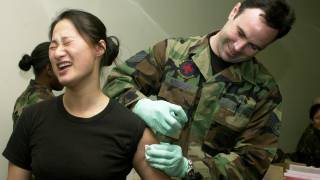Nationwide Mumps Outbreak at ICE Facilities

US authorities have placed about 5,200 adults in medical quarantine in immigrant detention centers related to large numbers of mumps and chickenpox cases.
According to reporting by The Hill on June 14, 2019, the quarantine order affects people in 39 Immigration and Customs Enforcement (ICE) detention centers throughout the USA.
This report says 4,276 detainees have been quarantined for exposure to the mumps virus, 825 to chickenpox and 99 to both.
Previously, there were no confirmed mumps cases detected among ICE detainees before September of 2018. Since then, ICE has logged 334 cases of mumps among detainees at numerous facilities.
According to the Centers for Disease Control and Prevention (CDC), from January to May 24, 2019, 42 US states and the District of Columbia, reported mumps infections in 1,002 people.
“From an operational perspective, the impact is significant in the short and long term and will result in an increase in cohort detainees’ length of stay in detention, an inability to effect removal of eligible detainees, and postponing scheduled consular interviews,” said Nathalie Asher, executive associate director for ICE Enforcement and Removal Operations (ERO).
“Preventing the spread of communicable diseases in ICE custody is something we have demonstrated success doing," Asher said.
ICE offers asymptomatic, exposed detainees vaccines to protect them from diseases.
The mumps and chickenpox viruses are easily preventable through vaccination, says the CDC.
The mumps virus is a Rubulavirus in the Paramyxovirus family and is spread by droplets of saliva or mucus from the mouth, nose, or throat of an infected person, usually when the person coughs, sneezes or talks.
And, chickenpox is a highly contagious disease caused by the varicella-zoster virus. It can cause an itchy, blister-like rash. The rash appears first on the chest, back, and face, and then spreads over the entire body.
Each year, more than 3.5 million cases of chickenpox, 9,000 hospitalizations, and 100 deaths in the USA are prevented by chickenpox vaccination, says the CDC.
CDC officials say 'it's never too late to be immunized.'
But, the measles-mumps-rubella (MMR) vaccine does not cure infected people after disease onset. In the USA, there are 2 approved measles vaccines, MMR-II and ProQuad.
Additionally, the CDC says there is ongoing mumps risk is related to potential ‘waning’ protection from the MMR vaccine.
According to a Harvard study, the MMY vaccine-derived immune protection against mumps persists on average for just 27 years, after the last administered dose.
In response to this information, the CDC released new guidance suggesting when the 3rd dose of mumps vaccine is appropriate.
Recent mumps virus news:
- Mumps Outbreak Reaches Houston
- More Mumps Approaching South Texas
- Southern Texas Mumps Outbreak Reaches 13 Confirmed Cases
- Indiana University Mumps Outbreak Reveals Waning MMR Vaccine Protection
Any vaccine can cause side effects, which should be reported to a healthcare provider, or the CDC.
Our Trust Standards: Medical Advisory Committee

























